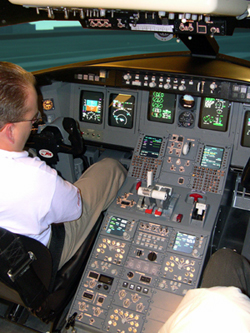
At ATP, the last stage in flight training is our Regional Jet Standards Certification Program. It is designed to expose a student to the accelerated pace of a Part 121 airline training program. Learning to perform up to airline standards will greatly increase your chances of success when you have to do it during Initial Flight Training at your new airline. A good Jet Transition course like ours is designed to help a pilot make several transitions actually.
Here you will transition from:
Piston driven props to high-bypass turbofan jet engines
Piston engines react very quickly to applications or reductions in power.“Recips” can produce instantaneous thrust with the downside being a relative lack of power and reliability.
Jet engines are very reliable because they spin around on the inside to produce thrust, and are very smooth and safe. They are also capable of producing great amounts of thrust. Turbofan engines take time to “spool up” and begin to produce the desired thrust compared to the immediate response of recips.

Analog “steam gauge” instruments to “all-glass” instrumentation
Most of us spend years perfecting our scan of the standard instrument cluster in general aviation aircraft we learn to fly in. Then we transition to an all glass cockpit and have to throw a lot of that away. The flightdeck of the RJ houses six TV tubes which can be loaded with so much information that it becomes hard to decipher. At that point the classic scan is useless and pilots learn to resort to “the stare”. Once you get used to the difference a glass cockpit is much more useful than steam gauges.
From single pilots operations to a Crew environment
The biggest transition that has to be made is from a single pilot operation to a crew environment. The challenge is that for the first time in your flying career you have to interact closely with another aviator to get the job done. When you get hired by an airline they will send you their flight profiles to learn and memorize. These profiles are like scripts and they contain the “callouts” that pilots make during an operation such as a take-off, as well as the points in a maneuver where the aircraft is configured for the phase of flight you are in.
When you fly a four day trip at your new job, you could fly with as many as four different Captains. These Captains will arrive in the cockpit without time for lengthy discussions about how things are done. He or she will sit down in their seat, open their flight case and say something like, “Hi, my name is Bob. Let’s run the Before Start Checklist” and he will expect you to know how to do it. You will also be depending on them to know their callouts and profiles.
These transitions are all important to someone hoping to do well in Initial Flight Training at an airline. Making those transitions before you arrive for airline training is preferable, and advisable. It is also a lot of fun.

